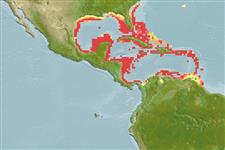Environment: milieu / Zona climática / intervalo de profundidade / distribution range
Ecologia
marinhas associadas(os) a recifes; não migratória; intervalo de profundidade 1 - 100 m (Ref. 110583), usually 15 - 55 m (Ref. 110583). Tropical; 33°N - 9°S, 98°W - 57°W
Western Atlantic: southern Florida and the western Gulf of Mexico to the West Indies-Caribbean region and Venezuela.
Tamanho / Peso / Idade
Maturidade: Lm ? range ? - ? cm
Max length : 10.0 cm TL macho/indeterminado; (Ref. 47838)
Espinhos dorsais (total) : 13 - 14; Raios dorsais (total) : 18 - 19; Espinhos anais: 3; Raios anais : 14 - 16. Upper half of body yellow-orange, shading into blackish basally in dorsal fin; lower half of body white; orange bands on head and a narrow orange bar on caudal peduncle (Ref. 13442).
Body shape (shape guide): short and / or deep; Cross section: compressed.
Inhabit deep coral-rich reefs and drop-offs (Ref. 47838). Feed on small invertebrates. Often seen nibbling on the tube feet of sea urchins or the tentacles of tubeworms (Ref. 9710). Unlike some chaetodonts it does not pick parasites from the bodies of other fishes (Ref. 5521). Solitary, sometimes in pairs (Ref. 47838). Seek refuge when approached (Ref. 47838). Oviparous (Ref. 205). Form pairs during breeding (Ref. 205).
Ciclo de vida ou comportamento de acasalamento
Maturidade | Reprodução | Desova | Ovos | Fecundidade | Larvas
Form pairs during breeding (Ref. 205).
Allen, G.R., R. Steene and M. Allen, 1998. A guide to angelfishes and butterflyfishes. Odyssey Publishing/Tropical Reef Research. 250 p. (Ref. 47838)
Status na Lista Vermelha da UICN (Ref. 130435: Version 2025-1)
Ameaça para os humanos
Harmless
Uso pelos humanos
Pescarias: espécies comerciais; Aquário: Espécies comerciais
Ferramentas
Relatórios especiais
Baixar XML
Fontes da internet
Estimates based on models
Preferred temperature (Ref.
123201): 22.9 - 28, mean 26.5 °C (based on 234 cells).
Índice de diversidade filogenética (Ref.
82804): PD
50 = 0.5001 [Uniqueness, from 0.5 = low to 2.0 = high].
Bayesian length-weight: a=0.02239 (0.01097 - 0.04568), b=3.01 (2.84 - 3.18), in cm total length, based on LWR estimates for this (Sub)family-body shape (Ref.
93245).
Nível Trófico (Ref.
69278): 3.4 ±0.2 se; based on diet studies.
Resiliência (Ref.
120179): Elevada, tempo mínimo de duplicação da população menor que 15 meses (Preliminary K or Fecundity.).
Fishing Vulnerability (Ref.
59153): Low vulnerability (10 of 100).
🛈
Nutrients (Ref.
124155): Calcium = 146 [72, 247] mg/100g; Iron = 1.07 [0.60, 1.90] mg/100g; Protein = 18.5 [17.3, 19.8] %; Omega3 = 0.142 [0.074, 0.269] g/100g; Selenium = 45.9 [21.7, 93.2] μg/100g; VitaminA = 45.7 [12.3, 175.3] μg/100g; Zinc = 1.78 [1.15, 2.66] mg/100g (wet weight);
